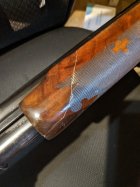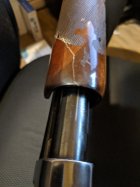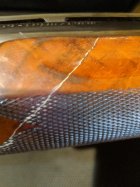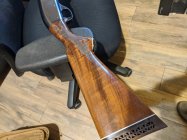@joshb could tell you a good way. Youll have to re break it
Hard to say if its ELMERS or an epoxy, there were a few epoxies that color back it the day that were that color.
A brown Sharpie would make it less noticable.
If that is wood glue, depending on which flavor, the repair may be pulled apart with water, alcohol and heat. The pva glues will come apart with water and aliphatic resins will come apart with heat.
A problem comes with trying to re-repair it. If you don't get all the glue off the surfaces, you might have glue adhesion problems.
The brown sharpie idea is easy. You could maybe scratch out the top layer with a knife and put a tiny skim of colored epoxy, like black in over the crack.
There is black superglue out there too. You may have to get some walnut and do a couple test pieces. Fixing a poor fix seems like it's always a tricky job.
Paint it or better yet have a professional paint it to match the different colors.
I have a suggestion. I have a very small V chisel used for jewelry engraving that I can send you. You can cut out the top of the glue line with it and fill the groove with a thickened epoxy mix. Then you sand it flat.
I Like what Josh has to say but think it may be too hard to control the epoxy. I would v it out just as Josh said but use a touch up crayon that finishers use to fix such things. If you want something more permeant and maybe more professional, find some one who refinishes furniture or touches up real wood custom cabinets. They have some kind of sticks in different colors that they heat up with an alcohol lamp and can mix the colors to get it perfect.
I have a suggestion. I have a very small V chisel used for jewelry engraving that I can send you. You can cut out the top of the glue line with it and fill the groove with a thickened epoxy mix. Then you sand it flat.
A single point checkering cutter might cut a finer line.
A single point checkering cutter might cut a finer line.
That would be easier to control. I have one of those, too.
I have a suggestion. I have a very small V chisel used for jewelry engraving that I can send you. You can cut out the top of the glue line with it and fill the groove with a thickened epoxy mix. Then you sand it flat.
Now were talking! I like that idea.
Alternatively, I read that water or alcohol can dissolve cured glue. I was pondering a method to break down the glue. Use a paper towel, damp with alcohol on the inside of the forend. This is under the assumption that the glue would soften and the bond could be broken. I'd then have to gently clean up the remaining glue, tooth brush and more alcohol sounds about right. Let the wood dry and repair with a better adhesive. Any reason to dismiss this method on the basis that the wood would be compromised by the alcohol?
Now were talking! I like that idea.
Alternatively, I read that water or alcohol can dissolve cured glue. I was pondering a method to break down the glue. Use a paper towel, damp with alcohol on the inside of the forend. This is under the assumption that the glue would soften and the bond could be broken. I'd then have to gently clean up the remaining glue, tooth brush and more alcohol sounds about right. Let the wood dry and repair with a better adhesive. Any reason to dismiss this method on the basis that the wood would be compromised by the alcohol?
The alcohol won’t hurt the wood. If the bond is good and solid, I would leave it and just fix the cosmetic issue.
I used to fix voids and such while making stock I would always keep some of the sanding dust from the stock so if I needed it I would mix with the glue and fill the voids, let dry and sand, then finish. If you decide to scrape V notch you could try that, and then if you need to do a little additional blending with the furiture sticks then hit it with a little shellac and blend it in, I have done many cabinets like that.
Now were talking! I like that idea.
Alternatively, I read that water or alcohol can dissolve cured glue. I was pondering a method to break down the glue. Use a paper towel, damp with alcohol on the inside of the forend. This is under the assumption that the glue would soften and the bond could be broken. I'd then have to gently clean up the remaining glue, tooth brush and more alcohol sounds about right. Let the wood dry and repair with a better adhesive. Any reason to dismiss this method on the basis that the wood would be compromised by the alcohol?
If that is wood glue, you need to get all the old stuff out. Wood glue does not stick to wood glue well. Epoxy may stick to the old glue you can't get removed but I've always made other reinforcements to keep the glue bond from being my only strength.
Check out Mark Novak's YouTube channel where he repairs old milsurps. Also, Frank Ford from Gryphon Guitars had good hints on repairs. One thing about repairing a guitar is that repair may be under a bunch of tension.
I would remove the top bit of the glue and use some black dyed epoxy to fill the crack. Then take a razor blade and run the edge along a screwdriver shaft at an angle to roll the edge over. Put a piece of tape on either end of the blade so you can scrape the epoxy with just the center of the blade and the tape will ride over the rest of the wood.
If it hasn't been done, glue a piece of fabric on the inside for reinforcement.
Call Alex at MasterClass stocks and show him these pictures.
I went straight to the source and it sounds like the adhesive is epoxy. I haven't had time to see if alcohol has any effect on the repair. If it is epoxy it kind takes my idea off the table.
I thought it looked like that old white epoxy with the green/blue hardener from back in the day.


















